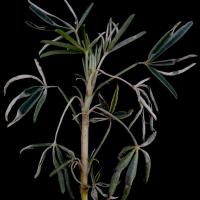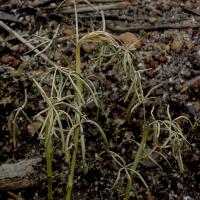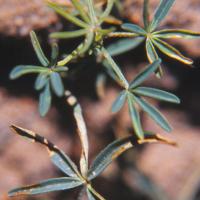Symptoms appear within hours (Group L), or one or two days (Group G) of application.
Diagnosing contact herbicide damage in narrow-leafed lupins
This includes herbicides from a range of chemical groups that require uniform spray coverage to be fully effective.
What to look for
- Widespread plant bleaching and limpness.
- Wind drift damage is worst on paddock edges. Temperature inversion drift occurs in low lying areas.
Paddock
- The pattern of damage reflects spray coverage and may be worse on one side of the plant. Plants die or recover with fresh new growth appearing.
- Numerous pale necrotic spots sometimes with a brown edge or streaks on the leaves and stems.
- More serious damage includes leaf wilting, marginal leaf burn and leaf death.
- Severely damaged plants shrivel up within four days of application.
Plant
What else could it be
| Condition | Similarities | Differences |
|---|---|---|
| Diagnosing group F herbicide damage in narrow-leafed lupins | Pale leaf blotches and streaks on sprayed leaves | These fade without causing any lesions. |
Where did it come from?

Time of herbicide application
- Serious damage is generally caused by direct spraying. Contact herbicide spots may be caused by spray drift, but plants will generally recover.
- Group G damage symptoms are greater when spraying occurs under humid, high temperature, high moisture, dewy and high sunlight conditions.
- Plant symptoms will also be greater where adjuvants such as oils are used. There has been no reported yield loss associated with adjuvent use.
- Bipyridl herbicides have some movement within a plant if sprayed at night, and consequently cause more damage than when sprayed in daylight
Further information
Page last updated: Thursday, 5 February 2015 - 9:51am





